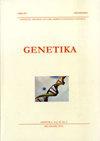分子标记技术在苜蓿不同基因型鉴定中的应用
4区 农林科学
Q3 Agricultural and Biological Sciences
引用次数: 0
摘要
为了育种成功,需要不断引进新的育种材料,并通过各种类型的杂交来增加现有的变异。本研究选用了10个不同地理来源的苜蓿品种。6个品种原产于塞尔维亚共和国(Krusevacka 22、Krusevacka 28、NS-Banat ZMS II、NS-Mediana ZMS V、Zajecarska 83和Cacanka 10), 3个品种原产于克罗地亚共和国(Osjecka 66、Osjecka 88和Osjecka 99), 1个品种原产于斯普斯卡共和国(Banjalucanka)。将10个紫花苜蓿品种各100粒种子放在培养皿中发芽。培养皿置于种子萌发室,温度为20℃。在黑暗中待了16小时30分?在阳光下晒8小时,持续7天。以苜蓿幼苗的第一个绿色小叶(子叶)进行DNA提取。主坐标分析的第一和第二轴占原始数据集中遗传变异的63.1%。可以清楚地观察到,Zajecarska 83基因型与其他已研究的卢塞恩基因型的遗传距离最远。这些研究证实,观察到的苜蓿品种的收集是可变的,足以成功的育种过程。使用适当的育种模式,可以为某些目的培育品种。本文章由计算机程序翻译,如有差异,请以英文原文为准。
Using molecular markers in the identification of different genotypes of lucerne (Medicago sativa L.)
In order to have successful breeding, it is necessary to introduce new breeding material constantly and to use it through various types of hybridisation to increase the existing variability. Ten (10) lucerne varieties of different geographic origin were used in the study. Six varieties originated from the Republic of Serbia (Krusevacka 22, Krusevacka 28, NS-Banat ZMS II, NS-Mediana ZMS V, Zajecarska 83 and Cacanka 10), three varieties originated from the Republic of Croatia (Osjecka 66, Osjecka 88 and Osjecka 99) and one variety originated from the Republika Srpska (Banjalucanka). A total of 100 seeds per each of 10 (ten) lucerne varieties were placed in Petri dishes to germinate. The dishes were placed in the seed germination chamber with the altering temperature of 20 o? in the dark for 16 h and 30 o? in the light for 8 h for seven days. The first green leaflets of lucerne seedlings (cotyledons) were used for the DNA extraction. The first and the second axes from the principal coordinates analysis accounted for a total of 63.1% of genetic variation, contained in the original dataset. It is clearly observed that the genotype Zajecarska 83 is genetically most distant from other studied lucerne genotypes. These studies confirmed that the observed collection of lucerne varieties is variable enough for the successful breeding process. Using an appropriate breeding model it is possible to breed varieties for certain purposes.
求助全文
通过发布文献求助,成功后即可免费获取论文全文。
去求助
来源期刊

Genetika-Belgrade
AGRONOMY-GENETICS & HEREDITY
CiteScore
1.80
自引率
0.00%
发文量
1
审稿时长
6-12 weeks
期刊介绍:
The GENETIKA is dedicated to genetic studies of all organisms including genetics of microorganisms, plant genetics, animal genetics, human genetics, molecular genetics, genomics, functional genomics, plant and animal breeding, population and evolutionary genetics, mutagenesis and genotoxicology and biotechnology.
 求助内容:
求助内容: 应助结果提醒方式:
应助结果提醒方式:


